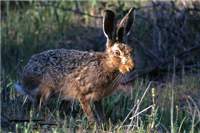Family
LeporidaeGenus
Lepus
Species
europaeus
Threats/Control Methods - Regional
Shooting is carried out in rural areas to control population numbers and limit the damage to crops and native vegetation. Population numbers are also controlled by the prolific spread of rabbits, which take the majority of resources and limit hare numbers.
Threats/Control Methods - Local
Currently there are no control methods for the hare within the ACT.Local/Urban Actions
In the unlikely event that a hare is spotted within the suburbs, it is not advisable to approach them closely. When confronted by humans or, if handled, wild adult hares become extremely stressed and may even die from a cardiac event. If caged or boxed, by inexperienced handlers, they become distressed and can potentially injure themselves fatally.
Common name/s
European Hare, Brown Hare, Hare, European Brown Hare, Jackrabbit
Distinguishing Features
Hares are very similar in appearance to Rabbits (Oryctolagus cuniculus ). The most outstanding differences are the larger body size, longer and more powerful hind legs and very long ears, which have a black tip. Their colouring is speckled brown with a white underside. They have red-brown legs and a light patch across the face from the eyes down to the dark nose. Hares can grow to a length of about 70 cm from their nose to the tip of their tail.
Similar Species
Rabbits (Oryctolagus Cuniculus) are very similar but substantially smaller and more abundant.
Distribution
The European hare is found in all Australian states, excepting WA and the NT.
Country of Origin
This species was introduced to
Survey Techniques
This species was identified visually during day and night searches and with scats.
Conservation (Pet/Pest) Status - National
Introduced Species. Common across its range. Its diet of agricultural makes it a pest in agricultural areas and the Australian Government classifies it as a minor pest.
Conservation (Pet/Pest) Status - Regional
Common, especially in open, agricultural areas.
Associated vegetation community
This species thrives on native grassland and open woodland.
Limiting Resources
This species requires open grassland and low-lying shrubs for food. Its numbers are known to drop in response to rising rabbit and fox (Vulpes vulpes ) numbers.
Breeding
Their slower reproductive cycle partly explains why rabbits out compete hares. Compared to rabbits, hares have much longer gestation periods, more selective breeding patterns, and smaller litters. Females give birth to around 3 litters each year of 2-3 leverets (young hares). Leverets are born with their eyes open and are left alone by the mothers all day to ward away predators not returning till sunset. In the wild, they usually live up to 10 years of age.
Behaviour
The brown hare is a nocturnal animal, so most of its feeding occurs during the night. They are shy and unlikely to be seen by residents of urban areas. Unlike rabbits which occur in borrows, hares are surface dwellers and during the day they rest in small depression in grassland environments. The Hare can run at up to 50km an hour over short distances.
Functional Group
Food Species
While hares prefer eating young shoots of grasses and herbs, they will also graze agricultural crops of vegetables and cereals in rural areas and on the bark of young fruit trees and wines.
Predators
Foxes (Vulpus vulpus) and Wedgetail Eagles (
Interesting Fact
The isolated populations of hares in parts of QLD are due to the sale of hares for coursing (bait for greyhound racing).
References - (reader suitability of references, P=Primary teachers, S=Secondary students, T=Tertiary students and researchers)
Books:Straham, R. 1983. The Australian Museum Complete Book of Australian Mammals. The National Photographic Index of Australian Wildlife. Angus and Robertson Publishers. Sydney. P, S, T
Online Publications:ARKive. 2007. Images of life of earth: Brown Hare. [online]. Available at:http://www.arkive.org/species/ARK/mammals/Lepus_europaeus/more_info.html P, S, T
Tidemann, C., Roscoe, T. and Mitchell, B. 2006. Mammals of the Lower Sullivans Creek Catchment, Canberra ACT. Prepared for the Life in the Suburbs project using data from the Lower Sullivans Creek Catchment Ecological Survey (LSCCES). Australian National University. Canberra. [online]. Available at: http://www.lifeinthesuburbs.com.au/category.php?id=65 S, T

 Top
Top Top
Top